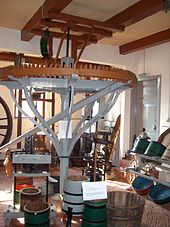Rheiderland local history museum
The Rheiderland Local History Museum , located in the former poor house in the East Frisian town of Weener, is dedicated to the history of the Rheiderland in 14 sections . Since May 1997 the house has had a branch with the Dollart Museum in Bunde . The museum is a member of the Ostfriesland Museum Association .
The development history of the region from the Stone Age to the present is shown. One focus is on economic history, especially brickworks and agriculture. The most important exhibit is the 16th century altarpiece of the oldest church in the Rheiderland, the Liudgeri Church in Jemgum- Holtgaste .
history
The building in which the museum is housed was built as a poor house by the city of Weener in 1791, based on the Dutch model. The founding of the museum goes back to an initiative of the Rheiderland Heimatverein founded in 1919. From 1926 onwards, he exhibited his extensive collections in the common room of the poor house, which has now been used as an old people's home, and later in the Kempe house on Neue Straße. In 1946 the association moved the museum to the east wing of the old people's home. The museum has expanded its premises several times and today uses a large part of the building for exhibitions. The old people's home moved into a new building.
Permanent exhibition
The museum shows almost exclusively objects from the Rheiderland on around 1500 square meters of exhibition space. The focus is on archeology, agriculture and handicrafts. You can see the results of the excavations in Jemgum , Boomborg , Hatzum and Weener. In the area of handicraft, the museum is dedicated to the history of the once 30 brickworks. You can also see the workshop of the last East Frisian nail smith and workshop facilities that were abandoned only a few decades ago.
The late Gothic Holtgaster altar shown in the museum was procured by the Holtgaster parish immediately before the turmoil of the Reformation. When it was delivered, the congregation had no more use for it, so they set it up in the church's cellar. It was discovered there in 1926 and brought directly to the museum. Its creator is unknown.
The library of the Heimatverein has more than 7000 titles and includes works of economic and church history, the prehistory and the history of the Frisians, writings on genealogy and heraldry, yearbooks, almanacs, protocols, documents, commemorative publications and biographies from the 16th century to the present day.
literature
- Herbert R. Marwede: Pre-Reformation altars in East Friesland . Dissertation, Hamburg 2007 ( online , PDF; 1.2 MB)
Web links
Individual evidence
- ↑ a b c Birkhild Haussmann: A museum you can touch . In: Ostfriesland Magazin . Issue 1/2001, p. 40ff. Quoted here from: Michael Heinze: Weener , viewed on May 27, 2013.
- ↑ Michael Heinze: Weener , accessed on May 27, 2013.
Coordinates: 53 ° 10 ′ 2.3 ″ N , 7 ° 21 ′ 10.3 ″ E



